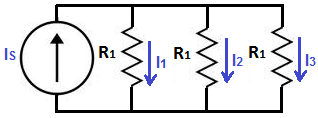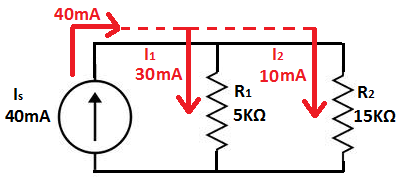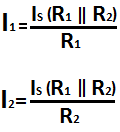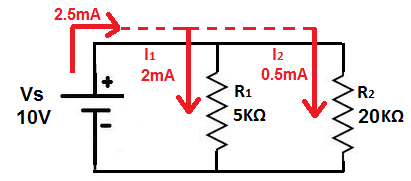Current Divider Circuit

In this article, we will go over what a current divider circuit is, how current divides up in a circuit, and how to mathematically calculate the current divisions that occur in a current divider circuit.
Note, that current divides up only in parallel circuits. In series, current is the same across all resistors (or loads).
So, as we are discussing current divider circuits, realize that we are dealing with parallel circuits.
What is Current Divider Circuit?
A current divider circuit is a circuit in which the main current from the power source is
divided up in the circuit; thus, different amounts of
current are allocated to different
parts of the circuit.
Current Divider Formula
The general formula to calculate the current flowing through a branch in any current divider circuit is shown below:

where IBRANCH is the current going through a certain branch (you are solving for),
IS is the current (power) source, RTotal
is the total equivalent resistance value of the resistors in parallel of the current divider circuit, and RBRANCH is the value of the resistance of
the branch for the current for which you are solving.
Look at the below circuit schematic to see current division in action.
Current Divider with a Current Source

The first type of current divider circuit we will go over is one in which the power source is a current source.
You can see how current divides up when a circuit is in parallel, as the two resistors above are.
When a circuit has resistors in parallel, the current from the power source (as you can see in this circuit is the 40mA current source) divides up in the parallel resistors.
Current always takes the path of least resistance. So, most of the current goes through the smaller-valued resistor, which in this case is the 5KΩ resistor. The higher-valued resistor offers greater resistance, so less current flows through it.
So if you want more current to flow through a particular part of a
circuit, put less resistance in that part of the circuit. Conversely, if you want less current to flow through a part of a circuit,
put more resistance in that
part of the circuit. This is how current division works.
Calculations
Now that you know conceptually how current division works in a circuit, let's go over exactly mathematically how current divides in a circuit based on the current (power) source of the circuit and the resistance values of the resistors or loads in the circuit.
Current divides up in a circuit based on the formula:

The current that goes through a branch in a parallel circuit is equal to the current from the current source multiplied by the equivalent parallel resistance of all the resistors in the current divider over the resistance of that particular branch (you are calculating).
In the above example, the main power source is 40mA.
The current which goes through the branch having
the 5KΩ resistor is:
I1= (40mA)(5KΩ || 15KΩ)/(5KΩ)= 30mA
The current which goes through the branch having
the 15KΩ resistor is:
I2= (40mA)(5KΩ || 15KΩ)/(15KΩ)= 10mA
Current Divider with a Voltage Source
You can also have a current divider circuit with a voltage source as the power source.
This also functions as a current divider, because the voltage source produces current which gets divided up in the circuit when resistors or loads in the circuit are in parallel.
Below is a current divider circuit with a voltage source:

Just like before, current takes the path of least resistance, so most of the current goes through the 5KΩ instead of the 20KΩ resistor.
Calculations
To find the value of the currents going through the individual parallel branches of a circuit, it is even simpler than a current source.
All we need to do to calculate the current values with a voltage (power) source is to use the current formula according to ohm's law:

Current equals voltage divided by resistance.
In the above example, the main voltage power source is 10V.
The current which goes through the branch having
the 5KΩ resistor is then:
I1= 10V/5KΩ= 2mA
The current which goes through the branch having
the 20KΩ resistor is:
I2= 10V/20KΩ= 0.5mA
A check you can do to find the total current in the circuit with a voltage source is to find the equivalent resistance value of all the resistors in parallel and then plug that value into the above formula. This will give the total current in the circuit before the current is divided into the individual parallel branches.
If you want to calculate the current division in a circuit, visit our Current Divider Calculator
. This calculator allows you to calculate the current which goes through any branch in a parallel circuit.
Related Resources
Voltage Divider Calculator
Capacitor Voltage Divider Calculator
